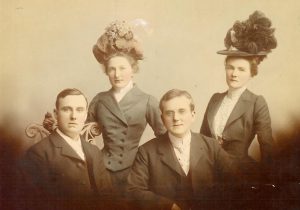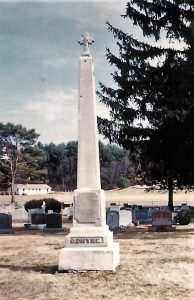In response to my query, an eminent genealogy colleague once advised me that there is little point in publishing information on families with no living descendants. My example here, I hope, counters that point. Tracing the provenance of an inherited mantle clock led me to the Philip O’Dwyre family of Willimantic, Connecticut.[1]
Born in Kilchrohane Parish, County Kerry, Ireland about two hundred years ago, Philip O’Dwyre, a true Famine refugee, fled his homeland in 1851. Leaving his infant son Philip and pregnant wife Julia in Ireland, he established a foothold in Willimantic before sending for his family. Philip kept a job working for the railroad and became, as Philip “Daware,” an American citizen in 1856. Willimantic censuses and baptismal and marriage registers from St. Joseph’s Church document the remaining eight children born to the couple. Philip bought several tenements on Valley Street, and the neighborhood became a mecca for other Kerry immigrants. In 1860, the “De Wire” household included Philip’s teenage nieces Bridget and Mary Lee. He thus became the anchor in a chain of immigration that lasted for decades.
Philip lived to a respectable old age. According to his death record, he was 77 – in fact, at least a decade older. His obituary in the Willimantic Chronicle on 3 October 1904 recounts that “He was prominent in the building of all railroad lines and was of splendid physique until taking sick about a year ago.” Of course, the obituary makes no mention that he died sitting under an apple tree in his back yard, a glass of whiskey at his side. The Chronicle also noticed Philip’s funeral, “one of the largest in years.” His pallbearers, all Kerry men, included nephew Philip Dwyer for whom the family patriarch had provided a first home in America. The latter, my grandfather’s uncle, moved to Leominster, Massachusetts, where he died in 1917. Completing the family circle of obligation and duty, my grandfather, Michael F. Dwyer, served as Philip’s pallbearer.
“He was prominent in the building of all railroad lines and was of splendid physique until taking sick about a year ago.”
One would think that, as the parents of nine children, Philip and Julia would have living descendants. Despite stability in Willimantic and dependable income, their family succumbed to the diseases of the time: their two elder sons, both dead at 28, from lung infections, and their three adult daughters from tuberculosis. Philip O’Dwyre Jr., a stonecutter, lived long enough to complete the family’s Celtic Cross monument in St. Joseph’s Cemetery. One side of the monument inscribes the date and place of Philip Jr.’s birth: Murreach, Dromod Parish, County Kerry. Philip got his money’s worth out this twenty-four-grave plot. The other three sides are filled with his children and grandchildren, the last of whom was buried in 1977.
Philip’s sister, Mary, wife of James Lee, also settled in Willimantic with her husband and younger children in the early 1860s. In 1900, Mary, having outlived five of her ten children, made her home with three widowed daughters and her son, Jeremiah Lee, a Civil War pensioner who outlived both of his wives. While death certificates reveal physical symptoms, they do not speak to the wounds of scarred psyches. It takes more than a generation to recover from the want and deprivation that Irish families experienced in the wake of famine. An unusual number of adults among the Dwyer kin never married, lived at home with their parents, or experienced childless marriages. Ironically, Philip’s sister Julia married in Willimantic at the age of 40, had only one child, but today she has the greatest number of living descendants.
 Frank O. Dwyer with his bride, Julia McNamara; William Brady; and Frank’s cousin Nell Hennessey in 1899.
Frank O. Dwyer with his bride, Julia McNamara; William Brady; and Frank’s cousin Nell Hennessey in 1899.
My knowledge of these Willimantic Dwyers deepened through a twenty-year friendship I enjoyed with the patriarch’s last surviving grandson, Walter Dwyer (1914–2010). The youngest son of Philip’s youngest son Frank, Walt regaled me for hours with family stories. When I initially contacted Walt, he was a little leery of a stranger calling him out of the blue. “My father told me our only relatives with the Dwyer name settled in Newport, Rhode Island.” I responded, “My grandfather was born in Newport.” That cemented our bond. This charming, hand-tinted photo of Walt’s father, Frank Dwyer, and his wedding party captures his strong resemblance to my relatives:
Studying Philip O’Dwyre’s family and their kinship network contributed important pieces to the mosaic of my family’s immigration story. They will never become extinct as long as they live in the memories of their collateral relatives.
Note
[1] Spelling has been standardized to Dwyer. Philip preferred O’Dwyre as a badge of Irish nationalism. His son Frank kept O. as a middle initial.
Share this:

About Michael Dwyer
Michael F. Dwyer first joined NEHGS on a student membership. A Fellow of the American Society of Genealogists, he writes a bimonthly column on Lost Names in Vermont—French Canadian names that have been changed. His articles have been published in the Register, American Ancestors, The American Genealogist, The Maine Genealogist, and Rhode Island Roots, among others. The Vermont Department of Education's 2004 Teacher of the Year, Michael retired in June 2018 after 35 years of teaching subjects he loves—English and history.View all posts by Michael Dwyer →
